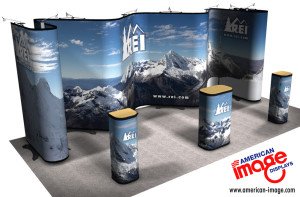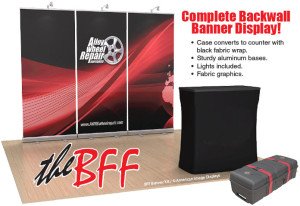4 Tips for Using Trade Show Booths to Boost Brand Loyalty
If you have a few minutes, it would be worth taking a look at this recent report I found from Ernst & Young, researching consumer buying habits. They have hard numbers backing up a lot of things we’ve been noticing and talking about experientially in marketing for a few years now: Consumers are increasingly defying traditional marketing niches, and must be addressed on more personal terms.
There’s a lot of good stuff in there, but I wanted to talk specially about brand perception and loyalty, since that’s one of the most important aspects of trade show displays. These matters are being upended thanks to how the Internet has empowered consumers, but in a literal world of competition, the winners will keep finding new ways to connect with customers.
And they can only do it by attempting to understand and reach out to their customers on an individual level, rather than relying on traditional marketing demographic predictions.
Building Brand Loyalty Matters At Trade Shows Today
According to their statistics, only 25% of Americans report being influenced by the reputation of a company. This has resulted in some consternation, or feelings that perhaps brand loyalty isn’t worth pursuing. However, for starters, I’d argue that this number is misleading and almost certainly low, for three reasons:
- As they address in the report, many Americans are forced to be budget-conscious. For many, it may simply be that they cannot afford to differentiate based on reputation, even if they would like to.
- Self-reporting on abstract concepts is notoriously flaky. Ask the same customer “Are you brand loyal?” and “Would you still buy (favorite brand) if (competitor) were 25% cheaper?” and you’ll likely get a large number of contradictory responses. Many consumers just don’t deal well with abstracts on polls.
- Speaking of contradictory results, here’s a report on a Dimensional Research study which shows 90% of respondents claim online reviews influence their buying. Similar studies into social media also show high reporting. And what is reputation if not what people are saying?
So it seems, people are likely far more influenced by reputation and perception than theybelieve themselves to be. Again, it’s going back to the problems of self reporting – people who don’t understand marketing concepts aren’t going to accurately report on their behaviors.
Basically, I believe they underestimate how important brand loyalty and reputation may actually be to modern consumers, which if anything, only underlines how important it is to reach out to your customers at every venue, trade shows included.
After all, if there is such a large spread of people who don’t believe themselves to be influenced by reputation, yet actually are, it creates a fantastic opportunity to make them more loyal to you through the most organic process possible: giving them what they want.
They Say You Never Go Broke Giving A Man What He Wants, But…
Plenty of people have gone broke by not knowing what he wanted. What I see here is not the death of market segmentations (a thought that would send most trade show designers into a panic) but a movement away from traditional categorization. That is to say, those niches will continue to exist, but they’ll be highly idiosyncratic and more specific to a company.
No matter how finely your market segment is broken down, it can still be broken down yet further. (It’s a variation on the old coastline paradox, really.) Even a business that services only one extremely specific service, like selling office supplies to government offices, they’re stillgoing to be able to segment that market. They are just going to have to start looking more deeply, into what differentiates individual customers.
Where were they educated? What do they like to eat? How important is family? Republican or Democratic background? East coast vs west coast? Boxers or briefs?
Of course, it gets more complex if, like most businesses, you cater to a wider array of customers. Imagine how much fun Nintendo must have attempting to simultaneously appeal to pre-teens, teens, soccer moms, and grandparents, in individualistic ways, using approaches that don’t step on the toes of their other outreach efforts.
This sort of sub-segmentation is thankfully made possible through the data-processing behind modern Internet marketing, and allows the information you collect at your trade show displays to go into a much larger pool of data on your customers. The more information you collect, the better your next exposition appearance will go because you’ll be able to fine-tune your strategies.
Twofer: Using Trade Show Displays To Better Know Your Customer And Boost Brand Loyalty
So, how can you put this into practical use? We’ve got a few suggestions beyond simply saying, “Give them lots of social media sharing options.”
- Have a spotter.No one notices someone twiddling with a phone or tablet in the background. Find someone on your team with a good eye for detail and get them to jot notes on trends they see in the people who come by: clothing, apparent income level, age\sex\race, married\not, and so forth. It can be as detailed as is possible, as long as it’s unobtrusive. The best insights you can find will be what differentiates those who stopped at your booth, versus the crowd at large that just walked past.
- Oh, just one thing…In conversations at your expo displays, try to slip in just one question, in a friendly tone: “What do you want in ____?” Don’t fill in the blank with your product name, but rather something specific to your industry. “Office supply solutions,” and such. Again, the more specific the better because specific questions get specific suggestions you could potentially act on. Plus, it’s amazing how often simply asking a lead what he wants will prolong the conversation. Few people can ever resist answering the question “What do you want?” when they think there’s a chance it might make a difference.
- Send follow-up surveys.Whenever you get someone’s email at a trade show, as part of your follow-up, invite them to do a quick survey on your trade show display. Always offer a freebie. They should get access to something exclusive like an eBook to download, or a mobile app, or some free swag. Just keep it as short as possible, preferably something that only takes a minute or two to complete.
- Show you pay attention.Have part of your trade show display talk about how you’ve can listen to and implement consumer ideas as part of your product\service development. It shouldn’t be a major aspect (unless you’re facing PR problems) but could be a single brochure, or a tablet kiosk with information on it. Showing that you honestly listen to the customers and give them what they want will make a big impression on them
The Dual-Purpose Trade Show Display
So, the short version here is, you should always look to both find out what your visitors want, and then actually give it to them. It seems simple when put that way, but it’s a lot more difficult than it sounds. Learn how to appeal to your audience at a core level, and your trade show exhibitions and display stands will help you put on more successful appearances that boost your brand loyalty!
